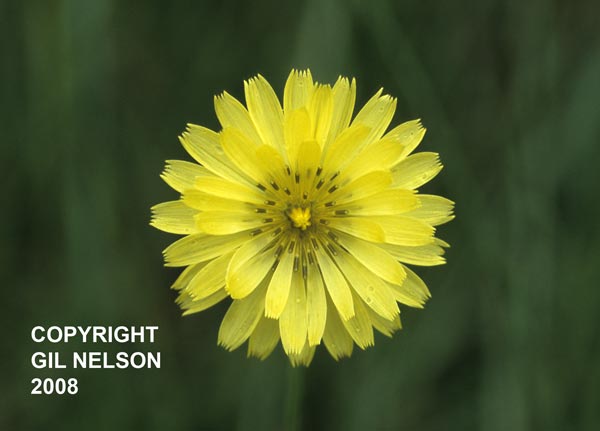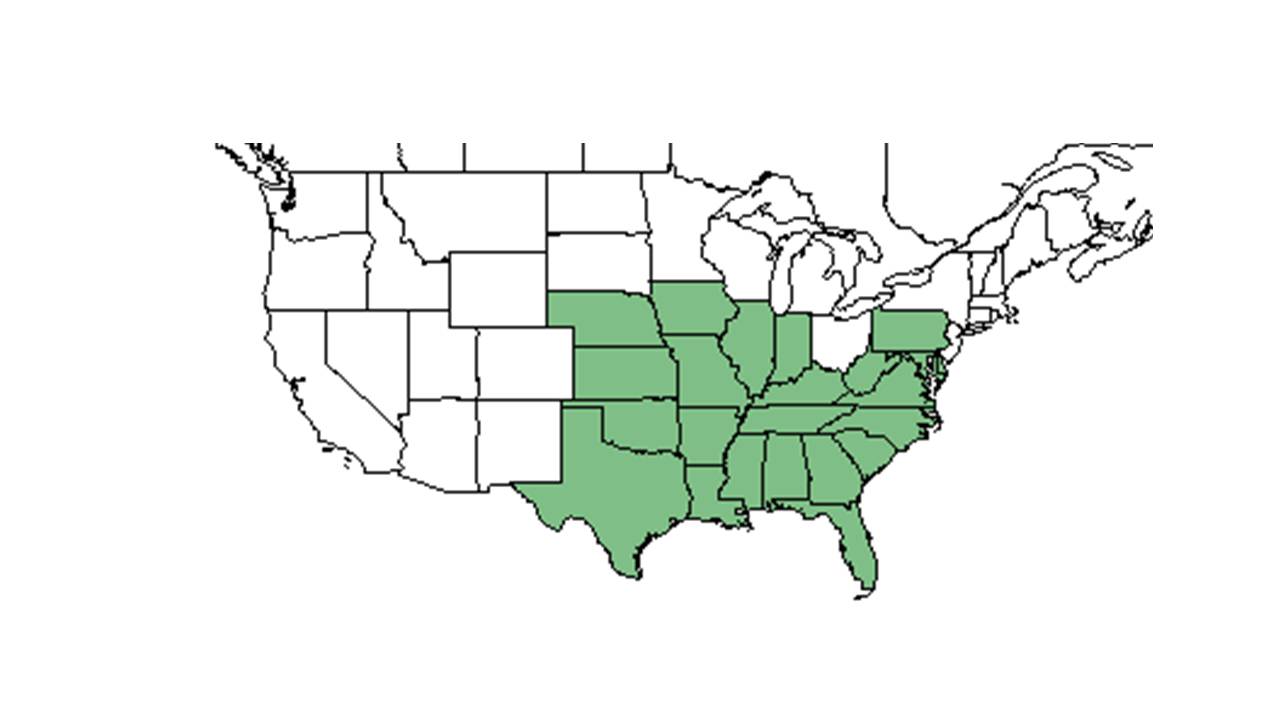Difference between revisions of "Pyrrhopappus carolinianus"
HaleighJoM (talk | contribs) (→Ecology) |
|||
| (29 intermediate revisions by 10 users not shown) | |||
| Line 15: | Line 15: | ||
| binomial_authority = (Walter) DC. | | binomial_authority = (Walter) DC. | ||
| range_map = PYCN_CARO_dist.jpg | | range_map = PYCN_CARO_dist.jpg | ||
| − | | range_map_caption = Natural range of ''Pyrrhopappus carolinianus'' from USDA NRCS [http:// | + | | range_map_caption = Natural range of ''Pyrrhopappus carolinianus'' from USDA NRCS [http://plants.usda.gov/core/profile?symbol=PYCA2 Plants Database]. |
}} | }} | ||
| + | |||
| + | Common names: Carolina desert-chicory, False-dandelion | ||
| + | ==Taxonomic notes== | ||
| + | Synonyms: ''Sitilias caroliniana'' (Walter) Rafinesque; ''Pyrrhopappus georgianus'' Shinners | ||
| + | |||
| + | Varieties: ''Pyrrhopappus carolinianus'' var. ''carolinianus'' RAB; ''P. carolinianus'' var. ''georgianus'' (Shinners) H.E. Ahles – RAB; | ||
| + | |||
==Description== | ==Description== | ||
<!-- Basic life history facts such as annual/perrenial, monoecious/dioecious, root morphology, seed type, etc. --> | <!-- Basic life history facts such as annual/perrenial, monoecious/dioecious, root morphology, seed type, etc. --> | ||
| + | A description of ''Pyrrhopappus carolinianus'' is provided in [http://efloras.org/florataxon.aspx?flora_id=1&taxon_id=220011313 The Flora of North America]. | ||
| + | |||
==Distribution== | ==Distribution== | ||
| − | + | ''P. carolinianus'' is a native plant with weedy tendencies.<ref name="Nelson 2005">Nelson, Gil. East Gulf Coastal Plain. a Field Guide to the Wildflowers of the East Gulf Coastal Plain, including Southwest Georgia, Northwest Florida, Southern Alabama, Southern Mississippi, and Parts of Southeastern Louisiana. Guilford, CT: Falcon, 2005. 173. Print.</ref> | |
==Ecology== | ==Ecology== | ||
===Habitat=== <!--Natural communities, human disturbed habitats, topography, hydrology, soils, light, fire regime requirements for removal of competition, etc.--> | ===Habitat=== <!--Natural communities, human disturbed habitats, topography, hydrology, soils, light, fire regime requirements for removal of competition, etc.--> | ||
| + | In the Coastal Plains in Florida and Georgia, ''P. carolinianus'' can be found in sandy old fields, sandpine-oak woodlands, moist banks bordering marshes, frequently burned mature longleaf pine-wiregrass communities, and annually burned savannas.<ref name="FSU Herbarium">Florida State University Robert K. Godfrey Herbarium database. URL: [http://herbarium.bio.fsu.edu http://herbarium.bio.fsu.edu]. Last accessed: July 2015. Collectors: Lisa Keppner, Ed Keppner, Bian Tan, Walter Judd, Loran C. Anderson, Robert K. Godfrey, Patricia Elliot, K. Craddock Burks, Gwynn W. Ramsey, Richard S. Mitchell, R. A. Norris, D. C. Hunt, Andre F. Clewell, R. Komarek. States and Counties: Florida: Bay, Columbia, Escambia, Franklin, Jackson, Jefferson, Leon, Liberty, Madison, Okaloosa, Wakulla, Washington. Georgia: Grady, Thomas. Compiled by Tall Timbers Research Station and Land Conservancy.</ref> It can also be found in ditches, dry sands along parking lots, sandy vacant lots, open fields by rivers, moist bottomland pastures, along roadsides, drying sand on upper beach, trails of coastal hammocks, clearings near buildings, shores of recently made ponds, along highways, lawns, old biocontrol plots, mowed areas, fire lanes, and an access path through sandhill to a limestone trail. Associated species include ''Lantana, Pinus palustris, Aristida stricta, Bumelia, Crataegus'', and ''Cenchrus.''<ref name="FSU Herbarium"/> | ||
| + | |||
| + | Soil types observed include sand, sandy loam, sandy peat soil, and loam soils.<ref name="FSU Herbarium"/> | ||
| + | |||
===Phenology=== <!--Timing off flowering, fruiting, seed dispersal, and environmental triggers. Cite PanFlora website if appropriate: http://www.gilnelson.com/PanFlora/ --> | ===Phenology=== <!--Timing off flowering, fruiting, seed dispersal, and environmental triggers. Cite PanFlora website if appropriate: http://www.gilnelson.com/PanFlora/ --> | ||
| − | + | ''P. carolinianus'' has been observed flowering from January to November with peak inflorescence in May.<ref name="Nelson 2005"/><ref>Nelson, G. [http://www.gilnelson.com/ PanFlora]: Plant data for the eastern United States with emphasis on the Southeastern Coastal Plains, Florida, and the Florida Panhandle. www.gilnelson.com/PanFlora/ Accessed: 13 DEC 2016</ref> | |
| + | <!--===Seed dispersal===--> | ||
| + | <!--===Seed bank and germination===--> | ||
| − | |||
| − | |||
===Fire ecology=== <!--Fire tolerance, fire dependence, adaptive fire responses--> | ===Fire ecology=== <!--Fire tolerance, fire dependence, adaptive fire responses--> | ||
| − | ===Pollination=== | + | Populations of ''Pyrrhopappus carolinianus'' have been known to persist through repeated annual burns.<ref>Robertson, K.M. Unpublished data collected from Pebble Hill Fire Plots, Pebble Hill Plantation, Thomasville, Georgia.</ref> |
| − | === | + | |
| − | ===Diseases and parasites=== | + | <!--===Pollination===--> |
| − | ==Conservation | + | ===Herbivory and toxicology===<!--Common herbivores, granivory, insect hosting, poisonous chemicals, allelopathy, etc--> |
| − | + | ''Pyrrhopappus carolinianus'' has been observed to host aphids such as ''Uroleucon sp.'' (family Aphididae), bees such as ''Bombus pensylvanicus'' (family Apidae), and plant bugs such as ''Lygus lineolaris'' (family Miridae).<ref>Discoverlife.org [https://www.discoverlife.org/20/q?search=Bidens+albaDiscoverlife.org|Discoverlife.org]</ref> | |
| + | <!--===Diseases and parasites===--> | ||
| + | |||
| + | ==Conservation, cultivation, and restoration== | ||
| + | ==Cultural use== | ||
==Photo Gallery== | ==Photo Gallery== | ||
| + | <gallery widths=180px> | ||
| + | </gallery> | ||
==References and notes== | ==References and notes== | ||
| − | |||
Latest revision as of 14:35, 15 July 2022
| Pyrrhopappus carolinianus | |
|---|---|

| |
| Photo taken by Gil Nelson | |
| Scientific classification | |
| Kingdom: | Plantae |
| Division: | Magnoliophyta – Flowering plants |
| Class: | Magnoliopsida – Dicotyledons |
| Order: | Asterales |
| Family: | Asteraceae ⁄ Compositae |
| Genus: | Pyrrhopappus |
| Species: | P. carolinianus |
| Binomial name | |
| Pyrrhopappus carolinianus (Walter) DC. | |

| |
| Natural range of Pyrrhopappus carolinianus from USDA NRCS Plants Database. | |
Common names: Carolina desert-chicory, False-dandelion
Contents
Taxonomic notes
Synonyms: Sitilias caroliniana (Walter) Rafinesque; Pyrrhopappus georgianus Shinners
Varieties: Pyrrhopappus carolinianus var. carolinianus RAB; P. carolinianus var. georgianus (Shinners) H.E. Ahles – RAB;
Description
A description of Pyrrhopappus carolinianus is provided in The Flora of North America.
Distribution
P. carolinianus is a native plant with weedy tendencies.[1]
Ecology
Habitat
In the Coastal Plains in Florida and Georgia, P. carolinianus can be found in sandy old fields, sandpine-oak woodlands, moist banks bordering marshes, frequently burned mature longleaf pine-wiregrass communities, and annually burned savannas.[2] It can also be found in ditches, dry sands along parking lots, sandy vacant lots, open fields by rivers, moist bottomland pastures, along roadsides, drying sand on upper beach, trails of coastal hammocks, clearings near buildings, shores of recently made ponds, along highways, lawns, old biocontrol plots, mowed areas, fire lanes, and an access path through sandhill to a limestone trail. Associated species include Lantana, Pinus palustris, Aristida stricta, Bumelia, Crataegus, and Cenchrus.[2]
Soil types observed include sand, sandy loam, sandy peat soil, and loam soils.[2]
Phenology
P. carolinianus has been observed flowering from January to November with peak inflorescence in May.[1][3]
Fire ecology
Populations of Pyrrhopappus carolinianus have been known to persist through repeated annual burns.[4]
Herbivory and toxicology
Pyrrhopappus carolinianus has been observed to host aphids such as Uroleucon sp. (family Aphididae), bees such as Bombus pensylvanicus (family Apidae), and plant bugs such as Lygus lineolaris (family Miridae).[5]
Conservation, cultivation, and restoration
Cultural use
Photo Gallery
References and notes
- ↑ 1.0 1.1 Nelson, Gil. East Gulf Coastal Plain. a Field Guide to the Wildflowers of the East Gulf Coastal Plain, including Southwest Georgia, Northwest Florida, Southern Alabama, Southern Mississippi, and Parts of Southeastern Louisiana. Guilford, CT: Falcon, 2005. 173. Print.
- ↑ 2.0 2.1 2.2 Florida State University Robert K. Godfrey Herbarium database. URL: http://herbarium.bio.fsu.edu. Last accessed: July 2015. Collectors: Lisa Keppner, Ed Keppner, Bian Tan, Walter Judd, Loran C. Anderson, Robert K. Godfrey, Patricia Elliot, K. Craddock Burks, Gwynn W. Ramsey, Richard S. Mitchell, R. A. Norris, D. C. Hunt, Andre F. Clewell, R. Komarek. States and Counties: Florida: Bay, Columbia, Escambia, Franklin, Jackson, Jefferson, Leon, Liberty, Madison, Okaloosa, Wakulla, Washington. Georgia: Grady, Thomas. Compiled by Tall Timbers Research Station and Land Conservancy.
- ↑ Nelson, G. PanFlora: Plant data for the eastern United States with emphasis on the Southeastern Coastal Plains, Florida, and the Florida Panhandle. www.gilnelson.com/PanFlora/ Accessed: 13 DEC 2016
- ↑ Robertson, K.M. Unpublished data collected from Pebble Hill Fire Plots, Pebble Hill Plantation, Thomasville, Georgia.
- ↑ Discoverlife.org [1]